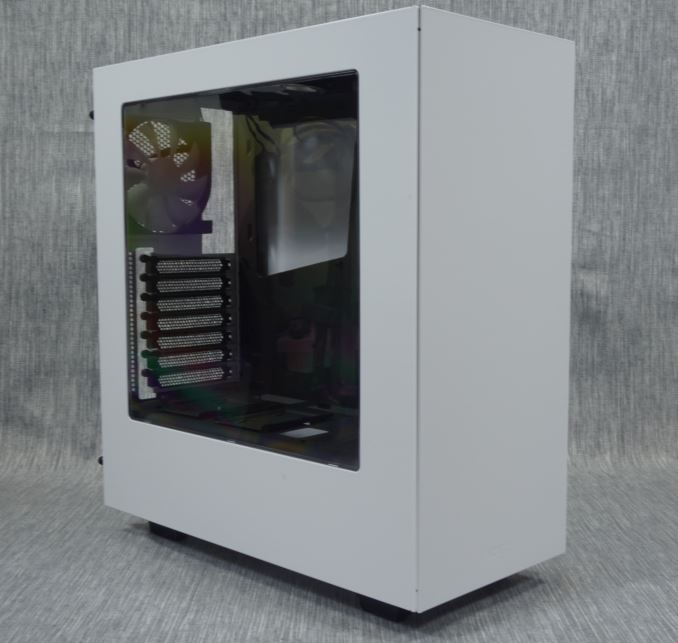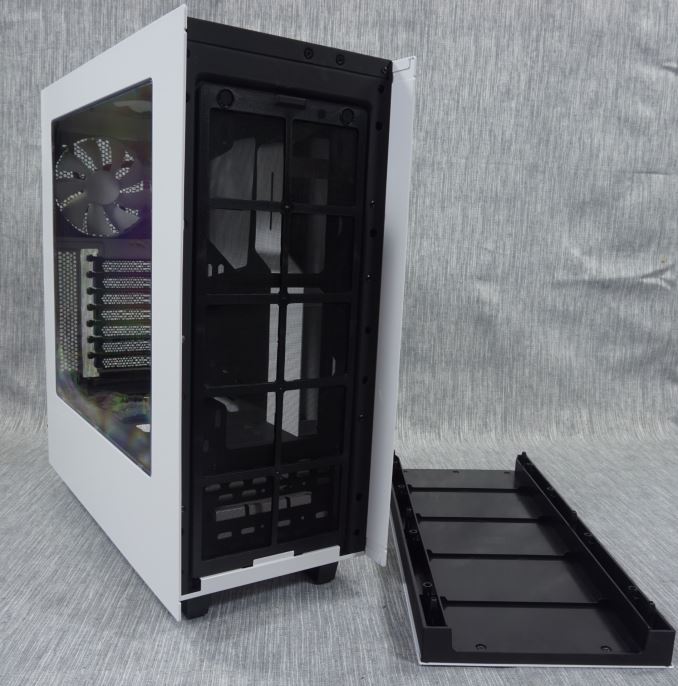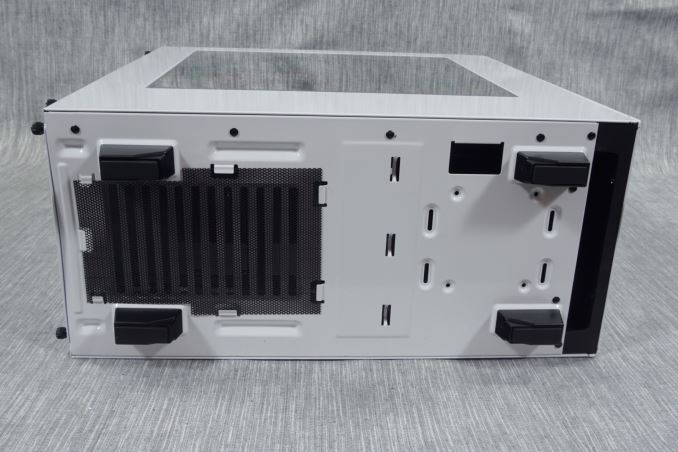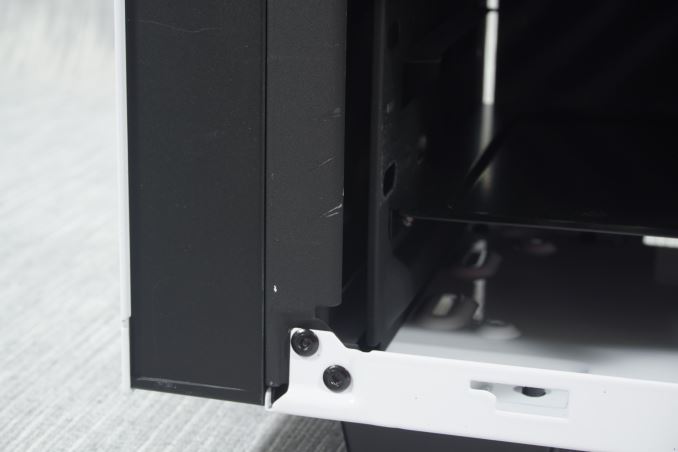The NZXT S340 Case Review
by E. Fylladitakis on July 13, 2015 8:00 AM EST- Posted in
- Cases/Cooling/PSUs
- NZXT
- Case
- ODD-Free
The Exterior of the NZXT S340
In terms of design, the S340 is just about as minimalistic as it gets. It literally is just a rectangular metallic box, with an entirely flat faceplate and side panels. Even the company logo that is embossed near the bottom of the faceplate is difficult to discern. We received the white version of the S340, which has a glossy exterior with matte black accents and a black interior. The left side panel of our sample is partially windowed, revealing the entire system compartment but leaving out the area where the PSU and the 3.5” drives are.
As we anticipated, the metallic faceplate is just a sheet of metal attached on a thick plastic frame. This is natural for both practical reasons and considering the price of the case. The flexibility of plastic allows for panels that can be easily attached to and removed from the metallic frame of the case, whereas a metallic construct would be heavy and it would definitely require some sort of locking mechanism or screws to stay in place. A very large nylon air filter covers the entire front of the case behind the front panel. As we mentioned in the introduction, there is not a single 5.25” device bay.
One of NZXT's primary marketing points regarding the S340 is its compact size. True enough, the S340 is very small for a tower case, with a volume of just 0.0384 cubic meters. This makes it even smaller than the Corsair Obsidian 350D (0.0416m3, 8% greater volume), a case that is limited up to micro ATX motherboards. It also is much smaller than the SilverStone Fortress FT05 (0.0456m3, 17.15% greater volume), which also is an "ODD-Free" design. The extensive use of steel makes the S340 a relatively slightly heavy case for its size, tipping the scales at 7 kg while completely empty.
Even though the interior of the case is black, the rear and bottom of the frame are sprayed with the same glossy white color as the faceplate and side panels. The PSU compartment is at the bottom of the case, where four thumbscrews are holding a cover in place. As we will see later, the PSU can only be installed by taking off this cover and inserting a PSU from the back of the case. A very basic metallic mesh filter can be found at the bottom of the case, covering the opening of the PSU intake. It also is noteworthy that the S340 has slightly tall feet for a case of this design and size.
The top of the S340 is matte black with all versions of the case, including the white version that we received for this review. The power on button, two USB 3.0 ports and the two headphone jacks can be found at the right front edge of the top panel. A LED ring surrounds the power on button, serving as the power on indicator.
The matte black color of the top and the interior of the case is very smooth and has an excellent feel to the touch. However, it also is very easy to scratch. This will be particularly obvious on the front frame, where the latches of the side panels lock. The matte paint at the sides of the front frame was already scratched when we removed them for the first time. One should be very, very careful when working with the S340, especially around its interior.

















48 Comments
View All Comments
Impulses - Monday, July 13, 2015 - link
People are so eager to ditch ODDs, might as well use USB hubs too instead of front ports! Just being facetious, I know the latter takes up little room, probably just a sacrifice in order to hit their price point.BrokenCrayons - Tuesday, July 14, 2015 - link
I'm not sure there's a good reason to push along the demise of optical media. Yes, very slow, takes a lot up a lot of space, and is losing relevance over time, but in a desktop system where space isn't typically a major concern there's not as much of a reason to abandon optical drives very quickly. Laptops, on the other hand, benefit from it because the space can be reclaimed to reduce the system's footprint, allocate space for more effective cooling, increase battery capacity or whatever else.Anyway, yes, it's probably a cost related matter that resulted in there being only a couple of USB ports and an external hub would solve the problem, though it'd be a sort of awkward solution to a problem that really shouldn't have existed in the first place.
Impulses - Tuesday, July 14, 2015 - link
Oh I agree, I still buy some movies AND music on disc and if I can have it in a bay I'd much rather have that than another external device cluttering my desk...There's already 3 displays, 2 amps (Emotiva for speakers, Asgard 2 for hp) and soon a DAC on my desk, and the external backup HDD occupies the sliver of space next to the case on the file cabinet it sits on.
I actually view half a dozen 3.5" bays (on other cases) as a larger waste of space than one or two 5.25" bays which can also be used for card readers, fan controllers, etc.
3.5" bays also tend to take up a sizeable chunk of internal space and they complicate thermals whereas a 5.25" bay can be designed in vertically or atop the entire rest of the chassis (without increasing it's volume outwards by more than the bay's thickness rather than a few 3.5" bays' length.
Dorek - Wednesday, July 29, 2015 - link
It's very rare that anyone needs to use more than two front-USB devices at once. I would say that situation has basically never happened to me.Steveymoo - Monday, July 13, 2015 - link
I thought I was seeing things for a minute there. ATI Radeon? Blast from the distant past!extide - Monday, July 13, 2015 - link
Yeah they look like Radeon 5800 series cards, I think.ES_Revenge - Monday, July 13, 2015 - link
Oh c'mon they're not *that* old. I'm guessing you also missed the mobo is P55--LGA1156? :P They probably just have "old" components lying around to do case reviews--it's not like you need a Haswell i7 in there and GTX 980 Tis, just to do a case review.I'm pretty sure I've seen this same components in other case reviews so they must be their go-to stuff for such reviews.
Dorek - Wednesday, July 29, 2015 - link
IMO they *should* be using new components and actually installing full systems in these cases, instead of this weird "fake computer load" thing this guy does. But everyone has mentioned this many times on the (somewhat useless) case reviews this guy does.jann5s - Monday, July 13, 2015 - link
why are there ATI radeons inside? feeling nostalgic?extide - Monday, July 13, 2015 - link
Older high end GPU's work great for testing clearances and cooling capabilities of cases. Performance doesnt matter but size and heat generation are similar to current cards. (Although the reviewer in this article uses simulated loads for thermal testing, not those GPU's)